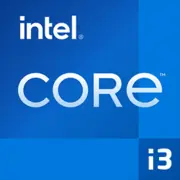Intel Core i3-13100F

Intel Core i3-13100F: Processore economico per giochi e lavoro nel 2025
Aggiornato: marzo 2025
Caratteristiche principali: Raptor Lake in formato compatto
Il processore Intel Core i3-13100F appartiene alla generazione Raptor Lake, ma mantiene le caratteristiche della sua linea economica. Si tratta di un chip quad-core con 8 thread grazie all'Hyper-Threading, il che gli consente di competere in compiti multi-thread. Il processo tecnologico Intel 7 (10 nm Enhanced SuperFin) offre un equilibrio tra efficienza energetica e prestazioni.
Parametri chiave:
- Frequenza base/massima: 3.4 GHz / 4.5 GHz (Turbo Boost 2.0).
- Cache: 12 MB L3 — il doppio rispetto all'i3-12100F.
- TDP: 58 W — si raffredda facilmente anche con il cooler di serie.
- Integrazione: Nessuna grafica integrata (indice "F"), quindi è necessaria una scheda video dedicata.
Prestazioni:
Secondo Geekbench 6, l'i3-13100F mostra 2280 punti in test single-core e 7760 in test multi-core. Questo è il 12% superiore rispetto all'i3-12100F, grazie all'ottimizzazione Raptor Lake. Nei giochi come Cyberpunk 2077 o Apex Legends, il processore offre stabilmente oltre 60 FPS in abbinamento a una scheda video di livello NVIDIA RTX 3060.
Caratteristiche architettoniche:
- Supporto PCIe 5.0 (16 linee) — rilevante per SSD di nuova generazione.
- Tecnologie Intel Thread Director per l'ottimizzazione dei thread nelle applicazioni ibride.
Schede madri compatibili: socket LGA 1700 e scelta del chipset
L'i3-13100F utilizza il socket LGA 1700, compatibile con i chipset delle serie 600 e 700.
Chipset raccomandati:
1. H610/B660 (DDR4): Opzione economica per PC da ufficio. Esempio: ASUS Prime H610M-K ($85).
2. B760 (DDR5): Scelta ottimale per build da gaming. Esempio: MSI Pro B760M-A WiFi ($140).
3. Z690/Z790: Eccessivi per i3, ma adatti per un upgrade a i5/i7.
Importante:
- Potrebbe essere necessario aggiornare il BIOS sulle schede della serie 600.
- Per PCIe 5.0, scegliere modelli con supporto Gen5 (ad esempio, Gigabyte Z790 UD).
Memoria supportata: DDR4 vs DDR5
Il processore supporta DDR4-3200 e DDR5-4800, ma il tipo di memoria dipende dalla scheda madre.
Confronto:
- DDR4-3200 (CL16): Opzione accessibile (32 GB — $70), adatta per giochi e attività quotidiane.
- DDR5-4800 (CL40): Più costosa (32 GB — $110), ma offre un aumento del 5-10% nei giochi dipendenti dalla CPU (Microsoft Flight Simulator, CS2).
Raccomandazione: Per una build economica, scegliere DDR4. Se si prevede un aggiornamento — DDR5.
Alimentatore: requisiti minimi e consigli
Con un TDP di 58 W, il processore non richiede un alimentatore potente.
Calcolo della potenza:
- Senza scheda video: 300 W.
- Con RTX 3060 (170 W): 500 W (raccomandato 80 Plus Bronze).
- Con RTX 4070 (200 W): 650 W (80 Plus Gold).
Esempi di alimentatori:
- EVGA 500 BR ($50) — per RTX 3050.
- Corsair CX650M ($80) — per RTX 4060.
Pro e contro dell'i3-13100F
Pro:
- Prezzo: $120 (nuovo) — uno dei CPU più accessibili del 2023-2024.
- Efficienza energetica: adatto per case compatti.
- Prestazioni nei giochi: non inferiore all'Ryzen 5 5500.
Contro:
- 4 core: limitazioni nelle applicazioni di heavy multi-threading (rendering, streaming).
- Nessuna grafica integrata: impossibile avviare il PC senza scheda video.
Scenari di utilizzo: dove l'i3-13100F mostra il suo potenziale
1. Giochi: Ideale per il gaming in Full HD con GPU di livello RTX 3060/RX 6600. In Fortnite (Epic) — 90 FPS, in Elden Ring — 60 FPS.
2. Attività da ufficio: Multitasking con diverse schede, Excel, Zoom.
3. Multimedia: Streaming video 4K, montaggio in DaVinci Resolve (progetti fino a 1080p).
Limitazioni: Non adatto per 3D rendering in Blender o lavoro con reti neurali.
Confronto con i concorrenti
1. AMD Ryzen 5 5500 ($100): 6 core, ma più debole nei test single-core (Geekbench 6 SC: 1980). Meglio nel multi-thread.
2. Intel Core i5-12400F ($160): 6 core/12 thread, Geekbench 6 MC: 9200. Scelta per chi ha bisogno di margine per il futuro.
3. Ryzen 5 5600 ($130): Prestazioni superiori nei giochi (+8%), ma più costoso.
Conclusione: l'i3-13100F vince in termini di prezzo e consumo energetico, ma perde rispetto ai modelli a 6 core nel multi-threading.
Consigli per assemblare un PC con i3-13100F
1. Cooler: Il dissipatore di serie è sufficiente, ma per un funzionamento silenzioso considera il DeepCool AG400 ($20).
2. Scheda madre: B760 + DDR5, se il budget lo consente.
3. Scheda video: Non risparmiare — RTX 3060 o RX 7600.
4. Storage: SSD PCIe 4.0 (WD Black SN770 1 TB — $80).
Errori:
- Acquistare Z790 per i3 è eccessivo.
- Usare DDR5-6000 — il processore non supporta tali frequenze.
Conclusione finale: a chi si adatta l'i3-13100F?
Questo processore è un'ottima scelta per:
- Giocatori con budget limitato: Massimo FPS per $120.
- PC da ufficio: Affidabilità e basso consumo energetico.
- Media center domestici: Streaming 4K senza lag.
Perché nel 2025?
Nonostante l'uscita di nuove generazioni, l'i3-13100F rimane attuale grazie al suo prezzo basso e alla compatibilità con le piattaforme moderne. È un "lavoratore instancabile" per chi non è pronto a pagare per una potenza eccessiva.
I prezzi sono aggiornati a marzo 2025.
Di base
Specifiche della CPU
Specifiche della memoria
Varie
Classifiche
Rispetto ad altre CPU
Condividi sui social media
Oppure linkaci
<a href="https://cputronic.com/it/cpu/intel-core-i3-13100f" target="_blank">Intel Core i3-13100F</a>